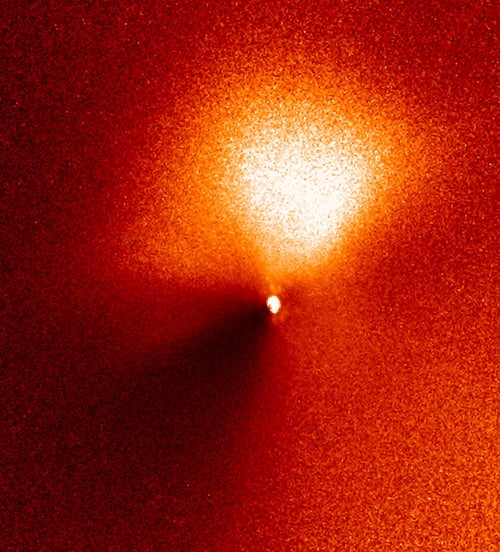Two weeks ago, astronomers thought comet material outbursts were rare. Now, thanks to Deep Impact, its host of technical partners, and one accommodating comet, scientists are getting both a close-up look of such activity and a preview of what to expect when Deep Impact’s package smashes into Comet Tempel 1 July 4.
“Outbursts … may be a very common phenomenon on many comets,” says University of Maryland astronomer and leader of the Deep Impact mission Michael A’Hearn. “We likely would have missed [these] exciting events, except that we are now getting almost continuous coverage of the comet with Deep Impact’s spacecraft imaging and spectroscopy instruments.”
On June 14, Hubble’s Advanced Camera for Surveys’ High Resolution Camera provided detailed views of a 1,320-mile long jet extending from the comet’s nucleus toward the Sun. Deep Impact’s onboard cameras also photographed the outburst.
Eight days later, on June 22, Tempel 1 treated Deep Impact project scientists to yet another outburst. This material ejection was 6 times larger than the June 14 outburst. Deep Impact’s onboard spectrometer measured water vapor amounts in the comet’s coma nearly doubled and amounts of other gases increased more than that during the June 22 outburst. The ejected material dissipated in about half a day.
The double shot of outbursts in just 2 weeks leads astronomers to consider such activity as commonplace for comets as they approach the Sun.
Project scientists hope these outbursts are a preview of what to expect from the impactor’s collision with Tempel 1. The impact of the projectile should release dust, ice, gas, and fragments from the comet. As it does, Deep Impact will record the encounter with three instruments: a medium-resolution digital camera, a high-resolution digital camera, and a spectrometer.
The mission’s principal investigator Michael A’Hearn tells Astronomy the most significant aspect of the second outburst is that it occurred while the spacecraft was simultaneously imaging the comet and monitoring its near-infrared spectrum.
“We saw big changes in the spectrum, both in the continuum and in the emission bands of molecules, and this was the first real test of our spectrometer for a scientifically interesting problem,” he says, noting the spectrometer is performing beyond its designed specifications. “This outburst taught us that the results on the comet will be spectacular.”
Thanks to the two outbursts, project engineers are confident Deep Impact’s instruments are ready for the main event July 4. According to Deep Impact’s co-investigator, Jessica Sunshine, “We already are able to see changes in the makeup of the fresh material extruded from the comet.”
What, if anything, will telescopes on the ground and in orbit see when the impactor hits? “This really depends on the physical nature of the comet,” A’Hearn says. “There are models — not the most likely models, but still models that are possible — that predict relatively little to be seen by Earth-based — ground and orbit — facilities.
“All mission scientists feel confident, but not certain, they’ll get an impact in the location they want,” says Lee Tune, a science writer on the team.
The best bet, say scientists, is a big crater with lots of ejecta, but there are other possibilities. For example, the penetrator could bore straight through Tempel 1, carving out a tunnel. Whatever happens, astronomers don’t expect the icy nucleus will break apart from the strike.
Team members are already thinking about a possible future rendezvous between Deep Impact and another comet — without, of course, the fireworks.
“We would like to go on to another comet, Comet Boethin, but we haven’t received permission nor funding to do that,” science team member Lucy McFadden tells Astronomy. “We await the impact for decisions on the future of the Deep Impact spacecraft.”










